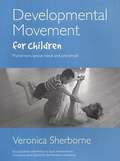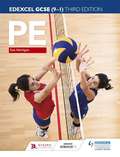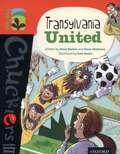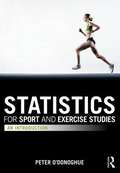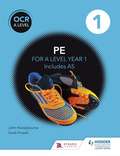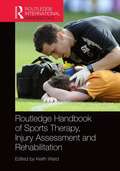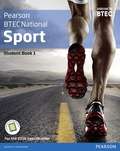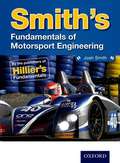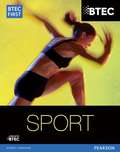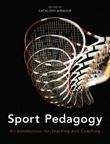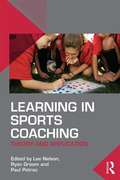- Table View
- List View
Paralympic athletics (Large Print)
by Rnib BookshareOn this page there are images of a runner with a carbon fibre 'blade', a wheelchair racer, a man throwing a club and a man putting the shot. Each image has a dashed line image border. There is a locator dot shown, which will be at the top left of the page when the image is the correct way up. Runner with a blade (top left) This image shows a running man seen from the side. His leg to the right is amputated below the knee and is he wearing a 'blade' (a curving carbon fibre spring). His head is at the top centre of the image, with his body down the page and his arms extending to the left and right. He is wearing a singlet and shorts. One of his legs goes down and left from the knee, to the ground at the bottom of the image. His other leg goes down to the knee, where the 'blade' is fixed. Wheelchair racer (top right) This is an image of a wheelchair racer seen from the side and facing to the right. Her head, wearing a helmet, is at the top centre of the image. Her body curves down the page to the left and her one visible arm extends out to the left. Further down is the chair's large back wheel and to the right is a horizontal section of the chair's structure and a smaller front wheel. Both wheels are touching the surface of the ground at the bottom of the image. Club throwing event (bottom left) The club thrower is seen from the side and facing to the left. His head is at the top centre of the image and his body is down the page. He has one arm going left and up and one going right and down. Down from his body is the seat of the wheelchair and further down its two wheels are touching the ground. The club that he has just thrown backwards over his head is flying through the air in the top right of the image. Shot putting (bottom right) This athlete is about to put the shot (throw a heavy metal ball with a pushing motion). He is a double amputee, having lost his legs from the upper thigh down, and is seated on a high table to bring him up to a suitable height for the event.
Paralympic athletics (UEB Contracted)
by Rnib BookshareOn this page there are images of a runner with a carbon fibre 'blade', a wheelchair racer, a man throwing a club and a man putting the shot. Each image has a dashed line image border. There is a locator dot shown, which will be at the top left of the page when the image is the correct way up. Runner with a blade (top left) This image shows a running man seen from the side. His leg to the right is amputated below the knee and is he wearing a 'blade' (a curving carbon fibre spring). His head is at the top centre of the image, with his body down the page and his arms extending to the left and right. He is wearing a singlet and shorts. One of his legs goes down and left from the knee, to the ground at the bottom of the image. His other leg goes down to the knee, where the 'blade' is fixed. Wheelchair racer (top right) This is an image of a wheelchair racer seen from the side and facing to the right. Her head, wearing a helmet, is at the top centre of the image. Her body curves down the page to the left and her one visible arm extends out to the left. Further down is the chair's large back wheel and to the right is a horizontal section of the chair's structure and a smaller front wheel. Both wheels are touching the surface of the ground at the bottom of the image. Club throwing event (bottom left) The club thrower is seen from the side and facing to the left. His head is at the top centre of the image and his body is down the page. He has one arm going left and up and one going right and down. Down from his body is the seat of the wheelchair and further down its two wheels are touching the ground. The club that he has just thrown backwards over his head is flying through the air in the top right of the image. Shot putting (bottom right) This athlete is about to put the shot (throw a heavy metal ball with a pushing motion). He is a double amputee, having lost his legs from the upper thigh down, and is seated on a high table to bring him up to a suitable height for the event.
Paralympic goalball (Large Print)
by Rnib BookshareThis page shows a goalball court, a goalball, a pair of light-blocking eyeshades and a player rolling a ball. Each image has a dashed line image.Goalball court (left)At the top of the image is a heavy dashed line representing the back of the goal, which stretches across the full width of the court. Slightly down the page is the goal line with goalposts, marked by small circles, to the left and right. Further down are the three players in the team area, shown as crosses (the opposing team down the page are shown as dots). Down again a horizontal line marks the start of the landing area, and another line, called the high ball line, marks the start of the neutral area, which extends down to the heavy horizontal centre line. The lines in the top half of the court are repeated in the bottom half of the court, but the other way around. Goalball (top centre)This is an image of a goalball. It is made from blue rubber and has two bells inside it. There are four holes (shown as small clear circles) on opposite hemispheres to allow the sound of the bells to be heard. It has distinctive lines radiating from a circle in the centre. Light-blocking eyeshades (top right)These eyeshades are seen from the front. Their opaque lens is in the middle of the image. The headband curves round to the top of the image from either side, with a buckle on the one on the left.Goalball player rolling a ball (bottom right)This image shows a goalball player, seen from the side, on the right of the page and a ball on the left.The player's head is at the top of the image facing to the left. He is wearing eyeshades. His body, clothed in a t-shirt, is down the page and he has his arms extending to the right and left with protective pads on his elbows. His legs, further down the page, stretch out to the right and left. He is wearing padded shorts and protective pads on his knees.The player has just rolled the ball to the left, where it can be found moving in the bottom left of the image.
Paralympic goalball (UEB Contracted)
by Rnib BookshareThis page shows a goalball court, a goalball, a pair of light-blocking eyeshades and a player rolling a ball. Each image has a dashed line image.Goalball court (left)At the top of the image is a heavy dashed line representing the back of the goal, which stretches across the full width of the court. Slightly down the page is the goal line with goalposts, marked by small circles, to the left and right. Further down are the three players in the team area, shown as crosses (the opposing team down the page are shown as dots). Down again a horizontal line marks the start of the landing area, and another line, called the high ball line, marks the start of the neutral area, which extends down to the heavy horizontal centre line. The lines in the top half of the court are repeated in the bottom half of the court, but the other way around. Goalball (top centre)This is an image of a goalball. It is made from blue rubber and has two bells inside it. There are four holes (shown as small clear circles) on opposite hemispheres to allow the sound of the bells to be heard. It has distinctive lines radiating from a circle in the centre. Light-blocking eyeshades (top right)These eyeshades are seen from the front. Their opaque lens is in the middle of the image. The headband curves round to the top of the image from either side, with a buckle on the one on the left.Goalball player rolling a ball (bottom right)This image shows a goalball player, seen from the side, on the right of the page and a ball on the left.The player's head is at the top of the image facing to the left. He is wearing eyeshades. His body, clothed in a t-shirt, is down the page and he has his arms extending to the right and left with protective pads on his elbows. His legs, further down the page, stretch out to the right and left. He is wearing padded shorts and protective pads on his knees.The player has just rolled the ball to the left, where it can be found moving in the bottom left of the image.
Paralympic goalball (UEB Uncontracted)
by Rnib BookshareThis page shows a goalball court, a goalball, a pair of light-blocking eyeshades and a player rolling a ball. Each image has a dashed line image.Goalball court (left)At the top of the image is a heavy dashed line representing the back of the goal, which stretches across the full width of the court. Slightly down the page is the goal line with goalposts, marked by small circles, to the left and right. Further down are the three players in the team area, shown as crosses (the opposing team down the page are shown as dots). Down again a horizontal line marks the start of the landing area, and another line, called the high ball line, marks the start of the neutral area, which extends down to the heavy horizontal centre line. The lines in the top half of the court are repeated in the bottom half of the court, but the other way around. Goalball (top centre)This is an image of a goalball. It is made from blue rubber and has two bells inside it. There are four holes (shown as small clear circles) on opposite hemispheres to allow the sound of the bells to be heard. It has distinctive lines radiating from a circle in the centre. Light-blocking eyeshades (top right)These eyeshades are seen from the front. Their opaque lens is in the middle of the image. The headband curves round to the top of the image from either side, with a buckle on the one on the left.Goalball player rolling a ball (bottom right)This image shows a goalball player, seen from the side, on the right of the page and a ball on the left.The player's head is at the top of the image facing to the left. He is wearing eyeshades. His body, clothed in a t-shirt, is down the page and he has his arms extending to the right and left with protective pads on his elbows. His legs, further down the page, stretch out to the right and left. He is wearing padded shorts and protective pads on his knees.The player has just rolled the ball to the left, where it can be found moving in the bottom left of the image.
Wheelchair table tennis (Large Print)
by Rnib BookshareOn this page, there is a table tennis bat (paddle or racquet) seen from the front and the side, and two players taking part in a match. Each image has a dashed line image border. There is a locator dot shown, which will be at the top left of the page when the image is the right way up. Table tennis bat front view (top left) This is an image of a table tennis bat seen from the front. To the top left of the image is the oval-shaped head of the bat, and to the bottom right is the handle. Each side of the bat (the front and back) has a layer of sponge covered with a layer of soft, pimpled rubber. Table tennis bat side view (top right) This picture shows a table tennis bat seen from the side, revealing the different layers of material used to make it. The head of the bat is to the left of the image. Nearest the top of the image is the first layer of soft rubber with raised pimples on it. The pimpled side is glued to the sponge layer down the page, so that the outer surface is smooth. Further down is the wooden blade of the bat, another layer of sponge, and another layer of pimpled rubber â " this one facing down so that the pimples are on the outside of the bat. Each player will have preferences for different types of rubber, with pimples on the inside or outside, depending on their style of play. The pimples greatly increase the 'stickiness' of the bat and allow more spin to be applied to the ball. The handle of the bat is to the right of the image. Wheelchair table tennis match (bottom) This is an image of two players and a table tennis table seen from the side.On the left of the image is a player facing right. At the top left is his head and down the page is his body, with an arm extending to the right. He is holding a bat in his hand. His body goes down the page to a wheelchair, which has a large wheel to the left and a small wheel to the right, close to the floor at the bottom of the page. One leg can be found to the right of his body, extending to the right and down. The ball can be found to the right of the bat, flying through the air. The table stretches across the page to the player on the right. It has a leg on each side and one in the middle. The net is in the centre of the table, to the right of the ball. The player on the right is facing left, with his head to the top right of the image. His body is down the page; his arm with his hand holding a bat is to the left of this. He has another arm, which has been amputated at the elbow, just down from his head. Further down is part of his leg and down again the wheelchair can be found, with a small wheel to the left and a large wheel to the right.
Wheelchair table tennis (UEB Contracted)
by Rnib BookshareOn this page, there is a table tennis bat (paddle or racquet) seen from the front and the side, and two players taking part in a match. Each image has a dashed line image border. There is a locator dot shown, which will be at the top left of the page when the image is the right way up. Table tennis bat front view (top left) This is an image of a table tennis bat seen from the front. To the top left of the image is the oval-shaped head of the bat, and to the bottom right is the handle. Each side of the bat (the front and back) has a layer of sponge covered with a layer of soft, pimpled rubber. Table tennis bat side view (top right) This picture shows a table tennis bat seen from the side, revealing the different layers of material used to make it. The head of the bat is to the left of the image. Nearest the top of the image is the first layer of soft rubber with raised pimples on it. The pimpled side is glued to the sponge layer down the page, so that the outer surface is smooth. Further down is the wooden blade of the bat, another layer of sponge, and another layer of pimpled rubber â " this one facing down so that the pimples are on the outside of the bat. Each player will have preferences for different types of rubber, with pimples on the inside or outside, depending on their style of play. The pimples greatly increase the 'stickiness' of the bat and allow more spin to be applied to the ball. The handle of the bat is to the right of the image. Wheelchair table tennis match (bottom) This is an image of two players and a table tennis table seen from the side.On the left of the image is a player facing right. At the top left is his head and down the page is his body, with an arm extending to the right. He is holding a bat in his hand. His body goes down the page to a wheelchair, which has a large wheel to the left and a small wheel to the right, close to the floor at the bottom of the page. One leg can be found to the right of his body, extending to the right and down. The ball can be found to the right of the bat, flying through the air. The table stretches across the page to the player on the right. It has a leg on each side and one in the middle. The net is in the centre of the table, to the right of the ball. The player on the right is facing left, with his head to the top right of the image. His body is down the page; his arm with his hand holding a bat is to the left of this. He has another arm, which has been amputated at the elbow, just down from his head. Further down is part of his leg and down again the wheelchair can be found, with a small wheel to the left and a large wheel to the right.
Wheelchair table tennis (UEB Uncontracted)
by Rnib BookshareOn this page, there is a table tennis bat (paddle or racquet) seen from the front and the side, and two players taking part in a match. Each image has a dashed line image border. There is a locator dot shown, which will be at the top left of the page when the image is the right way up. Table tennis bat front view (top left) This is an image of a table tennis bat seen from the front. To the top left of the image is the oval-shaped head of the bat, and to the bottom right is the handle. Each side of the bat (the front and back) has a layer of sponge covered with a layer of soft, pimpled rubber. Table tennis bat side view (top right) This picture shows a table tennis bat seen from the side, revealing the different layers of material used to make it. The head of the bat is to the left of the image. Nearest the top of the image is the first layer of soft rubber with raised pimples on it. The pimpled side is glued to the sponge layer down the page, so that the outer surface is smooth. Further down is the wooden blade of the bat, another layer of sponge, and another layer of pimpled rubber â " this one facing down so that the pimples are on the outside of the bat. Each player will have preferences for different types of rubber, with pimples on the inside or outside, depending on their style of play. The pimples greatly increase the 'stickiness' of the bat and allow more spin to be applied to the ball. The handle of the bat is to the right of the image. Wheelchair table tennis match (bottom) This is an image of two players and a table tennis table seen from the side.On the left of the image is a player facing right. At the top left is his head and down the page is his body, with an arm extending to the right. He is holding a bat in his hand. His body goes down the page to a wheelchair, which has a large wheel to the left and a small wheel to the right, close to the floor at the bottom of the page. One leg can be found to the right of his body, extending to the right and down. The ball can be found to the right of the bat, flying through the air. The table stretches across the page to the player on the right. It has a leg on each side and one in the middle. The net is in the centre of the table, to the right of the ball. The player on the right is facing left, with his head to the top right of the image. His body is down the page; his arm with his hand holding a bat is to the left of this. He has another arm, which has been amputated at the elbow, just down from his head. Further down is part of his leg and down again the wheelchair can be found, with a small wheel to the left and a large wheel to the right.
Developmental And Adapted Physical Education (PDF)
by H. Clarke David ClarkeThis comprehensive book on developmental and adapted physical education is intended for physical educators in schools and colleges, although applications to physical reconditioning and corrective therapy in hospitals and rehabilitation centers can readily be made.
Developmental Movement For Children: Mainstream, Special Needs And Pre-school (PDF)
by Veronica SherborneCore text for the internationally renowned Sherborne children's developmental movement programme. A new forward and new resources listed. In this practical and thought-provoking book, Veronica Sherborne shows how developmental movement has a crucial role to play in the lives of all children. Central to her theory is the belief that relating to oneself and relating to other people are essential for the satisfactory development of us all. Developmental movement can be particularly beneficial to children with learning disabilities, children with physical disabilities, and children who are emotionally and behaviourly disturbed. The book offers practical help in understanding and meeting children's needs. It covers what to teach and why, and shows in detail - with the aid of marvellously expressive photographs - how to set about carrying out a planned programme of activities that are geared to the needs of specific groups.
Paralympic athletics (UEB uncontracted)
by Rnib BookshareOn this page there are images of a runner with a carbon fibre 'blade', a wheelchair racer, a man throwing a club and a man putting the shot. Each image has a dashed line image border. There is a locator dot shown, which will be at the top left of the page when the image is the correct way up. Runner with a blade (top left) This image shows a running man seen from the side. His leg to the right is amputated below the knee and is he wearing a 'blade' (a curving carbon fibre spring). His head is at the top centre of the image, with his body down the page and his arms extending to the left and right. He is wearing a singlet and shorts. One of his legs goes down and left from the knee, to the ground at the bottom of the image. His other leg goes down to the knee, where the 'blade' is fixed. Wheelchair racer (top right) This is an image of a wheelchair racer seen from the side and facing to the right. Her head, wearing a helmet, is at the top centre of the image. Her body curves down the page to the left and her one visible arm extends out to the left. Further down is the chair's large back wheel and to the right is a horizontal section of the chair's structure and a smaller front wheel. Both wheels are touching the surface of the ground at the bottom of the image. Club throwing event (bottom left) The club thrower is seen from the side and facing to the left. His head is at the top centre of the image and his body is down the page. He has one arm going left and up and one going right and down. Down from his body is the seat of the wheelchair and further down its two wheels are touching the ground. The club that he has just thrown backwards over his head is flying through the air in the top right of the image. Shot putting (bottom right) This athlete is about to put the shot (throw a heavy metal ball with a pushing motion). He is a double amputee, having lost his legs from the upper thigh down, and is seated on a high table to bring him up to a suitable height for the event."
Sports Balls (Large Print)
by RnibThis is a page showing four sports balls. There is a locator dot shown, which will be at the top left of the page when the image is the right way up. At the top of the page is an oval rugby ball. Below this are two smaller balls; the one on the left of the page is a cricket ball with a thick seam sewn down the middle and on the right of the page is a tennis ball with two curved seams. At the bottom is a football made from differently shaped and coloured patches sewn together.
Sports balls (UEB Contracted)
by Rnib BookshareThis is a page showing four sports balls. There is a locator dot shown, which will be at the top left of the page when the image is the right way up. At the top of the page is an oval rugby ball. Below this are two smaller balls; the one on the left of the page is a cricket ball with a thick seam sewn down the middle and on the right of the page is a tennis ball with two curved seams. At the bottom is a football made from differently shaped and coloured patches sewn together.
Sports Balls (UEB Uncontracted)
by RnibThis is a page showing four sports balls. There is a locator dot shown, which will be at the top left of the page when the image is the right way up. At the top of the page is an oval rugby ball. Below this are two smaller balls; the one on the left of the page is a cricket ball with a thick seam sewn down the middle and on the right of the page is a tennis ball with two curved seams. At the bottom is a football made from differently shaped and coloured patches sewn together.
Edexcel PE For GCSE (PDF)
by Sue HartiganEnsure your students are fully supported throughout their course with Edexcel PE for GCSE Third Edition. This reliable and accessible textbook is structured to match the specification exactly and will provide your students with the knowledge they need, while giving them the opportunity to build skills through appropriate activities. - Key questions to direct thinking and help students focus on the key points - Learning goals to keep you on track with the requirements of the specification - Summaries to aid revision and help all students access the main points - Definition of key words to aid and consolidate understanding of technical vocabulary and concepts - Activities to build conceptual understanding and sound knowledge and understanding, analysis, evaluation and application skills - New practical section to help you plan for the NEA
Oxford Reading Tree, Level 13, TreeTops Chucklers: Transylvania United (PDF)
by Steve Barlow Steve SkidmoreBook band 13 grey. Oxford level 13. With 35 hilarious novels, short stories, anthologies and comics, TreeTops Chucklers has something for everyone. Guaranteed to make reading a pleasure! Fantastic award-winning authors, funny stories and amusing artwork to make children laugh. Perfect for convincing even the most reluctant readers that reading is fun. Great way to extend your high achievers. A variety of text types, including comics, perfect for engaging reluctant readers
Statistics for Sport and Exercise Studies
by Peter O'DonoghueStatistics for Sport and Exercise Studies guides the student through the full research process, from selecting the most appropriate statistical procedure, to analysing data, to the presentation of results, illustrating every key step in the process with clear examples, case-studies and data taken from real sport and exercise settings. Every chapter includes a range of features designed to help the student grasp the underlying concepts and relate each statistical procedure to their own research project, including definitions of key terms, practical exercises, worked examples and clear summaries. The book also offers an in-depth and practical guide to using SPSS in sport and exercise research, the most commonly used data analysis software in sport and exercise departments. In addition, a companion website includes more than 100 downloadable data sets and work sheets for use in or out of the classroom, full solutions to exercises contained in the book, plus over 1,300 PowerPoint slides for use by tutors and lecturers. Statistics for Sport and Exercise Studies is a complete, user-friendly introduction to the use of statistical tests, techniques and procedures in sport, exercise and related subjects. Visit the companion website at: www. routledge. com/cw/odonoghue
OCR A Level PE Book 1 (PDF)
by John Honeybourne Sarah Powell*Includes AS level* Inspire, motivate and give confidence to your students with OCR PE for A Level Book 1. This reliable and accessible textbook will offer your students comprehensive support for both the academic and practical elements of the course. We are working in collaboration with OCR to produce this Student's Book - Key questions to direct thinking and help students focus on the key points - Diagrams to aid understanding - Summaries to aid revision and help students access the main points - Extension questions, stimulus material and suggestions for further reading to stretch, challenge and encourage independent thinking and a deeper understanding - Definition of key terms - again to aid and consolidate understanding of technical vocabulary and concepts - Activities to build conceptual understanding and sound knowledge and understanding, analysis, evaluation and application skills
Routledge Handbook of Sports Therapy, Injury Assessment and Rehabilitation
by Rob Di Leva Keith WardThe work of a sports therapist is highly technical and requires a confident, responsible and professional approach. TheRoutledge Handbook of Sports Therapy, Injury Assessment and Rehabilitationis a comprehensive and authoritative reference for those studying or working in this field and is the first book to comprehensively cover all of the following areas: Sports Injury Aetiology Soft Tissue Injury Healing Clinical Assessment in Sports Therapy Clinical Interventions in Sports Therapy Spinal and Peripheral Anatomy, Injury Assessment and Management Pitch-side Trauma Care Professionalism and Ethics in Sports Therapy The Handbook presents principles which form the foundation of the profession and incorporates a set of spinal and peripheral regional chapters which detail functional anatomy, the injuries common to those regions, and evidence-based assessment and management approaches. Its design incorporates numerous photographs, figures, tables, practitioner tips and detailed sample Patient Record Forms. This book is comprehensively referenced and multi-authored, and is essential to anyone involved in sports therapy, from their first year as an undergraduate, to those currently in professional practice.
Btec Nationals Sport: For The 2016 Specifications (PDF)
by Adam Gledhill Richard Taylor Louise Sutton Matthew Fleet Chris Manley Alex Sergison Chris LydonEach Student Book and ActiveBook has clearly laid out pages with a range of supportive features to aid learning and teaching: Getting to know your unit sections ensure learners understand the grading criteria and unit requirements. Getting ready for assessment sections focus on preparation for external assessment with guidance for learners on what to expect. Hints and tips will help them prepare for assessment and sample answers are provided for a range of question types including, short and long answer questions, all with a supporting commentary. Pause point features provide opportunities for learners to self-evaluate their learning at regular intervals. Each Pause point feature gives learners a Hint or Extend option to either revisit and reinforce the topic or to encourage independent research or study skills. Case study and Theory into practice features enable development of problem-solving skills and place the theory into real life situations learners could encounter. Assessment practice features provide scaffolded assessment practice activities that help prepare learners for assessment. Within each assessment practice activity, a Plan, Do and Review section supports learners' formative assessment by making sure they fully understand what they are being asked to do, what their goals are and how to evaluate the task and consider how they could improve. Literacy and numeracy activities provide opportunities for reinforcement in these key areas, placing the skills into a sport context. Dedicated Think future pages provide case studies from the industry, with a focus on aspects of skills development that can be put into practice in a real work environment and further study.
Routledge Handbook Of Sports Therapy Injury Assessment And Rehabilitation
by Rob Di Leva Keith WardThe work of a sports therapist is highly technical and requires a confident, responsible and professional approach. TheRoutledge Handbook of Sports Therapy, Injury Assessment and Rehabilitationis a comprehensive and authoritative reference for those studying or working in this field and is the first book to comprehensively cover all of the following areas: Sports Injury Aetiology Soft Tissue Injury Healing Clinical Assessment in Sports Therapy Clinical Interventions in Sports Therapy Spinal and Peripheral Anatomy, Injury Assessment and Management Pitch-side Trauma Care Professionalism and Ethics in Sports Therapy The Handbook presents principles which form the foundation of the profession and incorporates a set of spinal and peripheral regional chapters which detail functional anatomy, the injuries common to those regions, and evidence-based assessment and management approaches. Its design incorporates numerous photographs, figures, tables, practitioner tips and detailed sample Patient Record Forms. This book is comprehensively referenced and multi-authored, and is essential to anyone involved in sports therapy, from their first year as an undergraduate, to those currently in professional practice.
Fundamentals Of Motorsport Engineering (PDF)
by Josh SmithSmith's Fundamentals of Motorsport Engineering provides the ultimate guide to motorsport engineering and what to expect at the racetrack, with content to suit motorsport learners from Level 3 up to degree level. This new textbook provides Motorsports students and practitioners with the fundamental theory necessary to work and advance in the industry.
BTEC First in Sport Student Book (PDF)
by Pam Phillippo Mark Adams Julie Hancock Adam Gledhill Rob Armstrong Bob Harris Alex SergisonThis work covers all the mandatory units and a wide selection of optional units. Each unit is presented in topics to ensure the content is accessible and engaging for learners. Activities in each unit provide support and clear direction for learners and can be used in the classroom or for independent work.
Sport Pedagogy: An Introduction For Coaching And Teaching (PDF)
by Kathleen ArmourSport Pedagogy offers an essential starting point for anyone who cares about sport, education and young people. It offers invaluable theoretical and practical guidance for studying to become an effective teacher or coach, and for anyone who wants to inspire children and young people to engage in and enjoy sport for life. The book also focuses on you as a learner in sport, prompting you to reflect critically on the ways in which your early learning experiences might affect your ability to diagnose the learning needs of young people with very different needs. Sport Pedagogy is about learning in practice. It refers both the ways in which children and young people learn and the pedagogical knowledge and skills that teachers and coaches need to support them to learn effectively. Sport pedagogy is the study of the place where sport and education come together. The study of sport pedagogy has three complex dimensions that interact to form each pedagogical encounter: Knowledge in context -what is regarded as essential or valuable knowledge to be taught, coached or learnt is contingent upon historical, social and political contextual factors that define practice; Learners and learning -at the core of sport pedagogy is expertise in complex learning theories, and a deep understanding of diversity and its many impacts on the ways in which young learners can learn; Teachers/teaching and coaches/coaching - effective teachers and coaches are lifelong learners who can harness the power of sport for diverse children and young people. Gaining knowledge and understanding of the three dimensional concept of sport pedagogy is the first step towards ensuring that the rights of large numbers of children and young people to effective learning experiences in and through sport are not denied. The book is organised into three sections: background and context; young people as diverse learners; the professional responsibility of teachers and coaches. Features of each chapter include: research extracts, 'comments' to summarise key points, individual and group learning tasks, suggested resources for further reading, and reference lists to enable you to follow-up points of interest. This book provides you with some of the prior knowledge you need to make best use of teaching materials, coaching manuals and other resources. In so doing you, as a teacher or coach, will be well placed to offer an effective and professional learning service to children and young people in sport.
Learning In Sports Coaching: Theory And Application (PDF)
by Lee Nelson Ryan Groom Paul PotracThe facilitation of learning is a central feature of coaches' and coach educators' work. Coaching students and practitioners are, as a result, being expected to give increasing levels of thought towards how they might help to develop the knowledge and practical skills of others. Learning in Sports Coaching provides a comprehensive introduction to a diverse range of classic, critical, and contemporary theories of learning, education, and social interaction and their potential application to sports coaching. Each chapter is broadly divided into two sections. The first section introduces a key thinker and the fundamental tenets of his or her scholarly endeavours and theorising. The second considers how the theorist's work might influence how we understand and attempt to promote learning in coaching and coach education settings. By design this book seeks to promote theoretical connoisseurship and to encourage its readers to reflect critically on their beliefs about learning and its facilitation. This is an essential text for any pedagogical course taken as part of a degree programme in sports coaching or coach education.

